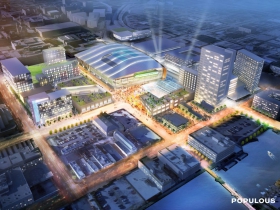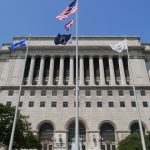Bucks Bailout Gets Even Bigger
And the proportion paid by local taxpayers keeps rising, which the Journal Sentinel still doesn't report.
Milwaukee Journal Sentinel columnist Dan Bice today offered an update on the financing for the Bucks arena that increased the cost for taxpayers. He reported an insider’s estimate that the $93 million in bonds to be issued by the Wisconsin Center District will probably cost $200 million when interest costs are included. Repayment of the district’s bonds, which will presumably be repaid by its hotel room and car rental tax (though that hasn’t been precisely spelled out) is likely to take many years, which will increase the interest costs.
It’s certainly a positive sign that the newspaper has begun to include the interest costs, something it hadn’t done for some time, but Bice’s story is still lacking in all sorts of ways.
First, the newspaper has yet to report the massive tax shift from state taxpayers to local taxpayers. The original plan called for the state to issue $220 in bonds, which was expected to cost $380 million with interest costs included, while the city and county would contribute $30 million, or about 7 percent of the total. Bice’s new total show local taxpayers now paying $327 million of an estimated total cost of $407 million, or 80 percent. I’d say that massive shift in who is paying is quite newsworthy.
-A property tax exemption on the arena which could result in a 30-year loss to taxpayers of as much as $450 million.
-A property tax exemption on any adjoining development by the Bucks, such as a beer garden, practice facility, public plaza, bars and restaurants, Bucks apparel and merchandise shops, etc. Assuming all that is worth some $200 million of the $500 million the Bucks have said they will spend on additional development, that would add another $179 million in lost property taxes over 30 years. (Both of these figures, as I’ve explained earlier, are estimates, and could change: the Bucks have suggested they expect to pay taxes of certain adjoining development, but the language in state law would have to be amended, and I’m told that city officials are pushing for such changes.)
-The state proposal for the Bucks arena also awards a sales tax exemption on “building materials, equipment and supplies used solely in the construction, renovation, or development of a sports stadium.” Assuming the cost of materials for the arena is, say, $300 million, that exemption would be worth about $17 million to the team.
-The proposal’s language also specifies that the “income of a sport and entertainment district would be exempt from the state corporate income and franchise tax.” This language is very broad and would seem to include anything the Bucks develop under the banner of an entertainment district. Given the state corporate income tax of 7.9 percent, this exemption could be huge.
-The creation of a tax exempt authority to help run a private company’s sports stadium allows Herb Kohl to claim his $100 investment in the new arena (which was part of the contract when he sold the team) as a charitable donation, meaning taxpayers will actually pay anywhere from $20 million to $36 million of his contribution, as I’ve reported.
-Federal and state tax exemptions on the bonds issued by the state and Wisconsin Center. My guess is this will be a small cost, perhaps several million dollars.
Assuming all of these exemptions are retained, the total cost to taxpayers will likely be in excess of $1.1 billion. These are all costs — property taxes, sales taxes, income taxes, etc. — a normal business pays. The only subsidy businesses typically get are a Tax Incremental Financing plan, which will provide about $12 million of the help the Bucks will get.
Bice also reported that both the city and county were originally asked to contribute to the arena by certifying their debt so the state could collect it, but only the county agreed to do this. Of course that was already reported by me. And no, Bice didn’t credit my story.
Nothing new about that. In a previous column, Bice reported about concerns by Democrats that current state party chair Mike Tate and a candidate to replace him, Jason Rae of Nation Consulting, would swap positions, with Tate getting a job at Nation Consulting. That, too, was previously reported by me.
I don’t blame Bice, as this appears to be the newspaper’s policy. Back in May, the late Don Walker wrote a story telling JS readers for the first time that (1) the arena proposal would also exempt parking lots, garages, restaurants, parks, concession facilities, transportation facilities and related structures; (2) the naming rights to the arena, which could gain the Bucks another $60 million, would not help pay to build the arena; and (3) the proposed governing board for the arena sports district would have 11 members, nine of whom would be appointed by the governor, with just two appointed by local officials. All of this had been previously reported by me, yet there was no credit to Urban Milwaukee or link to the story.
That’s okay, imitation is the sincerest form of flattery, and if over time, the newspaper begins to more frankly report this story, that will be good news indeed.
Arena Renderings
More about the New Bucks Arena
- Murphy’s Law: Bucks Violating Promises on Unions? - Bruce Murphy - Jun 5th, 2025
- Back in the News: Bucks Owners Continue to Cash In - Bruce Murphy - Nov 28th, 2022
- Murphy’s Law: Bucks Subsidy An Issue in US Senate Race - Bruce Murphy - May 9th, 2022
- Murphy’s Law: Bucks Franchise Worth $1.86 Billion - Bruce Murphy - Jan 25th, 2021
- Op Ed: County Parks Lost Funding to Bucks Arena - Patricia Jursik - Jul 7th, 2020
- Eyes on Milwaukee: Fiserv Forum Workers to Get $15/Hour - Jeramey Jannene - Jan 29th, 2020
- Eyes on Milwaukee: Bucks Beat Hiring Targets on Fiserv Forum - Jeramey Jannene - Nov 20th, 2019
- Murphy’s Law: Taxpayers Make Bucks, Brewers Rich - Bruce Murphy - Apr 16th, 2019
- Eyes on Milwaukee: Bucks Unveil Master Plan for Park East - Jeramey Jannene - Mar 15th, 2019
- Eyes on Milwaukee: Bucks Plan Massive Arena Signs - Jeramey Jannene - Feb 12th, 2019
Read more about New Bucks Arena here
Back in the News
-
Eric Hovde Has Another Bad Week
 Apr 22nd, 2024 by Bruce Murphy
Apr 22nd, 2024 by Bruce Murphy
-
Josh Kaul Investigating Fake Electors?
 Apr 17th, 2024 by Bruce Murphy
Apr 17th, 2024 by Bruce Murphy
-
State’s 7 Richest People Worth $72 Billion
![John Menard Jr. Photo by Travisvanvelzen (Own work) [CC BY-SA 4.0 (https://creativecommons.org/licenses/by-sa/4.0)], via Wikimedia Commons](https://urbanmilwaukee.com/wp-content/uploads/2020/09/John_menard_jr-1-e1630092418445-185x122.jpg) Apr 8th, 2024 by Bruce Murphy
Apr 8th, 2024 by Bruce Murphy
























well who would get to keep the money from the naming rights of a new arena
why cant they put a user fee on the tickets for the new arena to help pay for this.
Chuck, Bradley Center already charges user fees, which are used for maintenance. But the BC still is $20M in the hole because of high upkeep and high revenue share guaranteed the Bucks.
But if Milwaukee Art Museum can raise many millions from supporters, it seem arena boosters should be able to likewise raise some serious coin.
Chuck, the Bucks will get the money from selling the naming rights unless something different is spelled out — and very soon — in bill to create a new arena.
“… Bailout Gets Even Bigger”
The entitlement crowd rule/s.
So excited to watch sports at SPORTS 360 and party at RED ROBIN PRESENTS: THE BUCKS EXPERIENCE.
I sure as hell hope “they” are, but who is “they”? In other words, who do I write to to make sure something is done about it?
The interest payments are bad enough, but *developing* a city with *developing* its tax base is possibly the worst.
Chuck, you wondered about funding an arena with ticket fees. Neil deMause reported today on his “Field of Schemes” website that it would cost $41 per ticket to fund a $200M stadium in Boston:
http://www.fieldofschemes.com/2015/06/02/9194/using-ticket-tax-to-fund-new-revolution-stadium-in-boston-would-cost-fans-41-a-pop/
Maybe someone should push hard for owner/donor financing. Gouging fans and robbing from our children and grandchildren have serious drawbacks.
Bruce (or anyone) –
Has anyone determined the impact of the new arena or the financing deal on the Admirals and Marquette men’s basketball? It looks like Marquette has about 16 dates a year with roughly 240,000 paid attendance, and the Admirals have 35-40 dates a year with perhaps 200,000 paid attendance. However, it also seems like Marquette has far higher actual attendance per game than the Bucks, where 12,000 “paid attendance” on a winter weeknight doesn’t even fill the lower bowl. Marquette also seems to get more national exposure; they are on national / regional telecasts far more often than the Bucks.
Just curious whether Marquette or the Admirals have made any indication of where they will play and whether the finances will impact them in any way. Would / could the Admirals choose to move to the UWM Panther arena? Does the new arena even accommodate hockey?
Let me get this straight-public funds approaching a billion dollars over the course of the project to build a playpen for millionaires. This same crew of corporate whores in the GOP legislature are micro managing the food purchases of the poor. Truly the worst of us are now governing the rest of us.
Easy solution; have Edens and Lasry each do a sommersault and pick up the four hundred million that will have fallen out of their pockets and onto the floor!
The cost of the Brewer’s stadium is instructive. It was to be $400 million – sales taxing four counties at 0.1 percent (penny on $10) – and sunset after a short time. It continues to take from us, and gives to the Brewers $22 million per year, without any sign that the Brewer’s sun will set in Milwaukee and adjacent counties. Having been scammed once, and betting on our short term memory, they are back for more.
That annual $22 million would have allowed Milwaukee (for one example) to continue to sustain and build a modern transit system, and support a more reasonable fare structure.
The public discussion about the stadium was long and painful, and when a senator changed his mind his voters replaced him next election. Wiser now, the arena planners are going directly into the budget, which is how to cut the public out of the discussion. Each elected official can point to something in the budget that “must” be funded, in order to adopt things less popular.
Miller Park is also a “nonprofit” entity, giving back nothing to Milwaukee’s tax base. Jobs? For 88 days a year, a few people get minimum wages selling beer and hot dogs.
Bill Sell, Miller Park is the worst possible example you can give when trying to show an example of an arena or stadium that doesn’t not provide an economic impact. Miller Park has shown to be a shining example of a stadium that actually contributes millions more in outside revenue to the city than we pay in taxes.
To Rich, you could contact your state representatives regarding language of state law and its current exemption for ancillary development of a pro stadium or arena. DTY, if new arena built, Marquette seems ready to switch to playing there. Admirals not clear, could use UWM Panther arena. AG, are you saying Miller Park contributes more in revenue to metro area than cost of 5-county sales tax? I’ve never seen any research showing this.
Bruce, we’ve gone over this before. Direct taxes from purchases by people from outside the 5 county area combined with the income tax on players salaries alone equal almost $30 million a year. Conservative economic impact from people outside the 5 county area was estimated around $263 a year by a study commissioned by MLB.
Since that isn’t exactly the most unbiased of sources… I think we can safety assume the impact is somewhere between 0-$263 million though. So we see a net gain of somewhere between $30-300 million a year. Either way, it’s more than people pay in the sales tax per year.
http://www.bizjournals.com/milwaukee/news/2013/03/12/miller-park-adds-300m-to-local.html
Seems that these sports arena funding issues are the classic Red Queen race from Through the Looking Glass. “Now, here, you see, it takes all the running you can do, to keep in the same place. If you want to get somewhere else, you must run at least twice as fast as that!”
In order to keep a major sports team, the community has to do all of the running (taxing) it can. In the end, the community is in just the same place. Miller Park has had some impact because it can consistently attract a certain portion of attendees from outside of the area who are guaranteed a game (not a rainout), but overall there is very little net impact. Even the TGI Friday at the stadium seems far less patronized than other TGI Friday locations on non-game days.
It will be the same with the Bucks. Run, run, run to stay in the same place. Today, Milwaukee is a small-market NBA city with steady but unspectacular downtown growth. After $250 million in public funds, Milwaukee will remain a small-market NBA city with steady but unspectacular downtown growth. Some of that steady growth will be redistributed to the hedge fund execs who own the Bucks but it will be at the incremental expense of growth in other areas.
On the other hand, can you imagine the growth in jobs if the area could split the $250 million into $5 million for each of the area’s 25 largest employers and 25 largest high schools to make capital and equipment improvements that are otherwise not happening? Won’t happen because that’s just not our philosophy in this country, but it makes one think.
Is that the same Dan Bice you recently reported had “disappeared?” Bruce, the reason no one around here cites you as a credible source is the same reason we wouldn’t ask Larry King for marriage advice.
Meg, it’s not about “citing” me as an expert, it’s simply about crediting the first report of the same information later published by the Journal Sentinel. And it doesn’t just apply to information first reported by me, but by other reporters here and at other publications.
@Bill Sell good points. Some of those job projections being thrown out there (10,000, no 20,000, wait … 2,100, but lost of construction work!) have been ridiculous. This new arena and associated development will hardly be a good jobs generator. We learned this week from the Bradley Center that only 10% of the existing arena workers are full-time.
As for Miller Park, only a subset of the concession workers there make a union wage – much of the concession operations are staffed by non-profit charities. From a jobs standpoint, much of this Park East land could be put to better use. If this much public money got thrown at Kohl’s maybe they would have come to the Park East after all – those would have been real jobs.
Bruce, Meg is right. Dan doesn’t read your columns because of your track record of sloppiness. “He was so wrong on my disappearance why should be reading him on the arena?” Dan said.
I haven’t had a journalism course in quite some time. If someone does original reporting that a writer later uses in their own story, is there any obligation to give credit to the original source? Is it just a professional courtesy and considered on a case-by-case basis?
” it takes all the running you can do, to keep in the same place”
But your argument assumes that if the money isn’t given to the Bucks we will be in the same place which is not true because then the Bucks will leave and we will go way backwards. God knows what would happen to Park east if the Bucks leave but probably nothing, certainly nothing on the scale of what the Bucks are planning.
“On the other hand, can you imagine the growth in jobs if the area could split the $250 million into $5 million for each of the area’s 25 largest employers and 25 largest high schools to make capital and equipment improvements that are otherwise not happening?”
I feel like using the 250 million on the bucks would produce a lot more development/jobs because it would continue in perpetuity. These “improvements” would just be one time fixes, no?
“Miller Park has had some impact …but overall there is very little net impact.”
Not sure I agree, for one it gets a ton of use so there is a large social impact and not just economic impact.
Matt…. we threw an insane amount of money at Kohl’s….. and NML and ULine and Amazon and Mercury Marine and ManPower and Abbott Labs and soon we’ll throw more money at Johnson Controls. Suddenly we’re all upset about corporate welfare. I’ve only mentioned the big companies. I didn’t mention all the other grants and loans for small and disadvantaged businesses. You didn’t mention the $10M in income tax revenue the Bucks and other players generate for the state. That annual tax revenue, which will only increase, is equivalent to 2,500 jobs at $30,000 per year. The state does not want to lose that revenue.
For those of you that argue principle and say that this money should go to schools or regional transit……. guess what, it’s not.
Mark, thanks for the quote from Bice. That explains why he didn’t read the column, that’s his choice. But it doesn’t explain why the digital version of the stories have not added the credit to early stories and what they reported, now that this has been pointed out. I should add that the newspaper’s failure to credit other publications was a problem when I worked there, and was something then-editor Marty Kaiser mentioned to me once, with some frustration, as something he felt the paper should have done more routinely. It’s still a problem but is now more obvious because the online world has made everything more transparent and any reporter can easily check what was written on a subject by googling, which will quickly link you even to journalists or bloggers you don’t like or don’t read. I’ve found it helpful; as do most journalists in the world. I recommend it.
Since Bruce Murphy’s articles articles are heavily commented on, perhaps we can all agree he’s credible enough to be worth a read, and sometimes a response (unless anyone is “hate-reading”). I think it’s more than a “professional courtesy” to credit when another author/publication has broken a story, but there are gray areas on this. Not sure of JS policy, but they do sometimes note when another publication has reported something.
The only reason I know many facts about Miller Park and Bradley Center, especially on financing and tax issues, is because of Bruce’s reporting. Thanks again, Bruce. When I wrote an article for the Wisconsin Gazette recently, I cited his reporting on the likely total of public subsidies over a new arena’s lifespan. I also quoted Neil deMause, journalist/author of the “Field of Schemes” definitive book and national website on sports-venue funding (highly recommended!). I happily learned of Neil’s work from a citation in one of Bruce’s articles. Journalism (including blogging) can function like a tag team, esp. in our world when the pool of journalists shrinks by the day.
As for comments about how the Bucks must stay, and therefore we must give them $250M to do so (or $400M with interest), the reason that huge figure has held is because no politician has seriously challenged it. Neil deMause has reported on how a few cities have actually “negotiated” with teams to stay, not just “acquiesced,” as seems to be the case here. He quoted a negotiator who repped sports teams for 3 decades. Jim Nagourney said cities always get outfoxed because the teams always ask for the moon (as the Bucks have done) and the politicians rarely bother to say NO to anything significant (as appears to be happening here). Nagourney also says fleecing of taxpayers happens because pols and govt. attorneys are outgunned by team owners/reps who know where all the “real” revenue streams are and how to maneuver to get them.
I hope the deal is better than what has been leaked. I wish we taxpayers had a hard-bargainer, not just pols looking for stealth ways to play shell games with public money.
If the Milwaukee Art Museum can raise hundreds of millions for new buildings and expansions, why can’t arena boosters? Granted, current Bucks owners are new in town, but people have been pushing for a new arena for decades. Could it be that MAM assumes it must cultivate donor support, while sports teams assume they must simply cultivate political/business support to demand public funding? Nonetheless, as others have noted, Edens, Lasry, Dinan, Kohl (and a few friends) could cobble $250M together within hours. Instead, beleaguered politicians keep coming up with pretzel plans to rob our grandchildren and raid funds that should be going to schools, parks, et al. Alas!
@AG, thank you for the link to the “benefits” the Brewer’s bring to Milwaukee’s economy, and the link to the source of your numbers – a highly polished local PR firm hired by Major League Baseball. MLB has a need to sustain its rhetoric on baseball’s economic benefits. This self-serving “report” is aimed at the citizens beginning to waiver in their faith in the ball game. I’m not satisfied with it.
Specifically the MLB study “discounted” the substitution effect, which was nothing but vague reassurance that the study was being conservative (and therefore more “credible”). Clever rhetoric, but… But where are the numbers; why is there no analysis of benefit other than an anecdote about fans driving in from Wisconsin Rapids.
The MLB study does point to $13 million in sales tax revenue from the ball park, but some of that is from entertainment substitution by locals. But my main point is that a 1 percent sales tax on our public infrastructure (parks and transit) would have brought in over $100 million per year because of visitors’ (not local) spending. Commuters and tourist across the county would have enriched our parks and transit budgets with a substantive contribution to our economy. Other cities and regions have found sales taxes to be the ticket to regional transit, modern transit, tools that actually deliver workers to work, kids to school, and seniors to medical appointments – making a good city great is more than a baseball game, and more than a shell game.
@AG “Miller Park has shown to be a shining example of a stadium that actually contributes millions more in outside revenue to the city than we pay in taxes.”
I guess you’re saying something in excess of $2 billion. Two of the seven property taxing units in Milwaukee take in over $2 billion in revenue each year, from Milwaukee County residents and businesses. Where are your numbers?
It’s easy to justify investment in sports with high sounding “first class city” rhetoric, but can we justify our investment in the Brewers and Bucks with recognized accounting principles?
Bill…. again, no one is saying we don’t need improved public transit. Why do people continually make this an issue about choice. “Well if we put the money toward transit instead of a stadium we’d be better off”. I believe we should invest in regional transit, but that is more about regional politics and less about money. Didn’t outstate reps make it illegal for SE WI to form a regional authority for transit? Do you really think our leaders in Madison are going to get on that transit plan once they kill the arena plan? BTW…. the Brewers draw almost 3M people a year. I believe it was a good investment. Show me your numbers that say otherwise.
Meg Kissinger trolling your blog, Bruce. A sign that your reporting is causing some discomfort in your home town conflict of interest “newspaper”? I just can’t figure out why any politician would vote to give all of this money to the super rich. Maybe the Journal Sentinel should unleash Meg Kissinger, its crack investigative reporter, to uncover the graft that is surely behind this foolish public subsidy of New York hedge fund financiers.
Oh, on second thought, it looks like she might be too busy to work on the story because she’s trolling your blog.